WISE Announcement 02
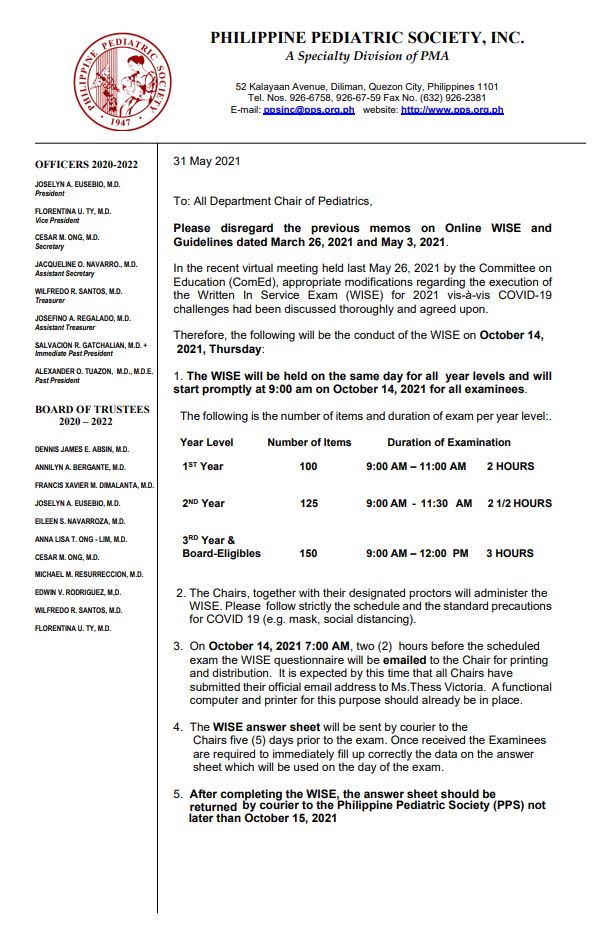
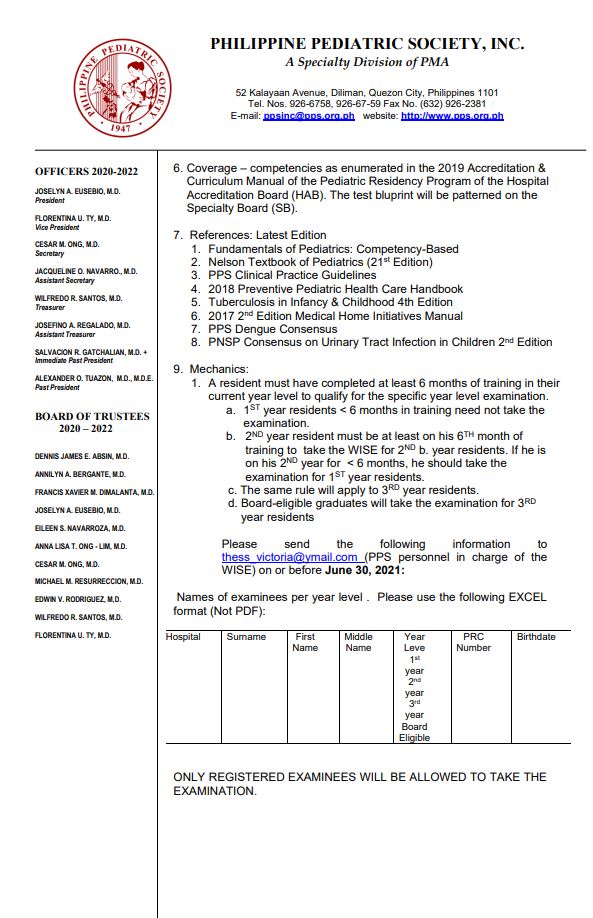
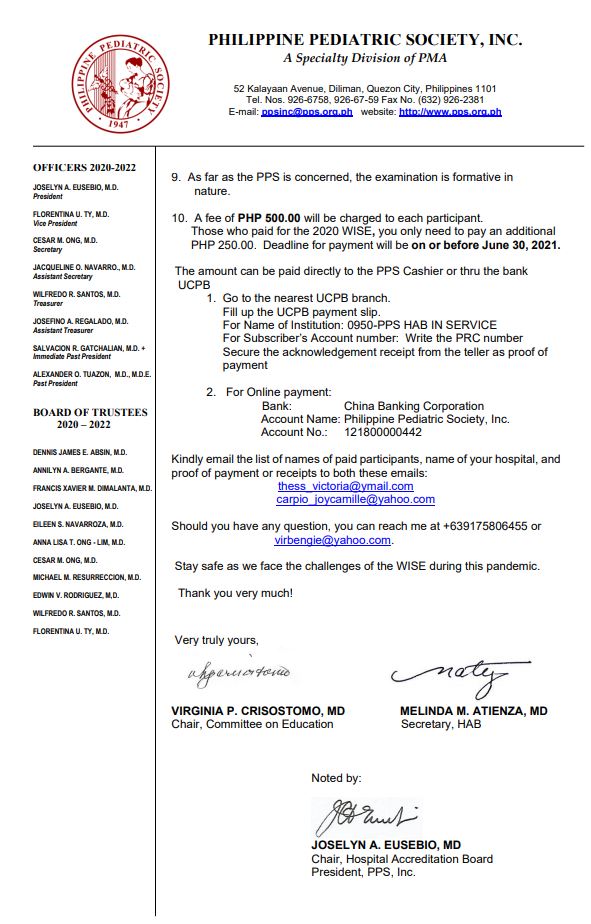
World No Tobacco Day 2021 Forum
Task Force on Mental Health Letter for Modules
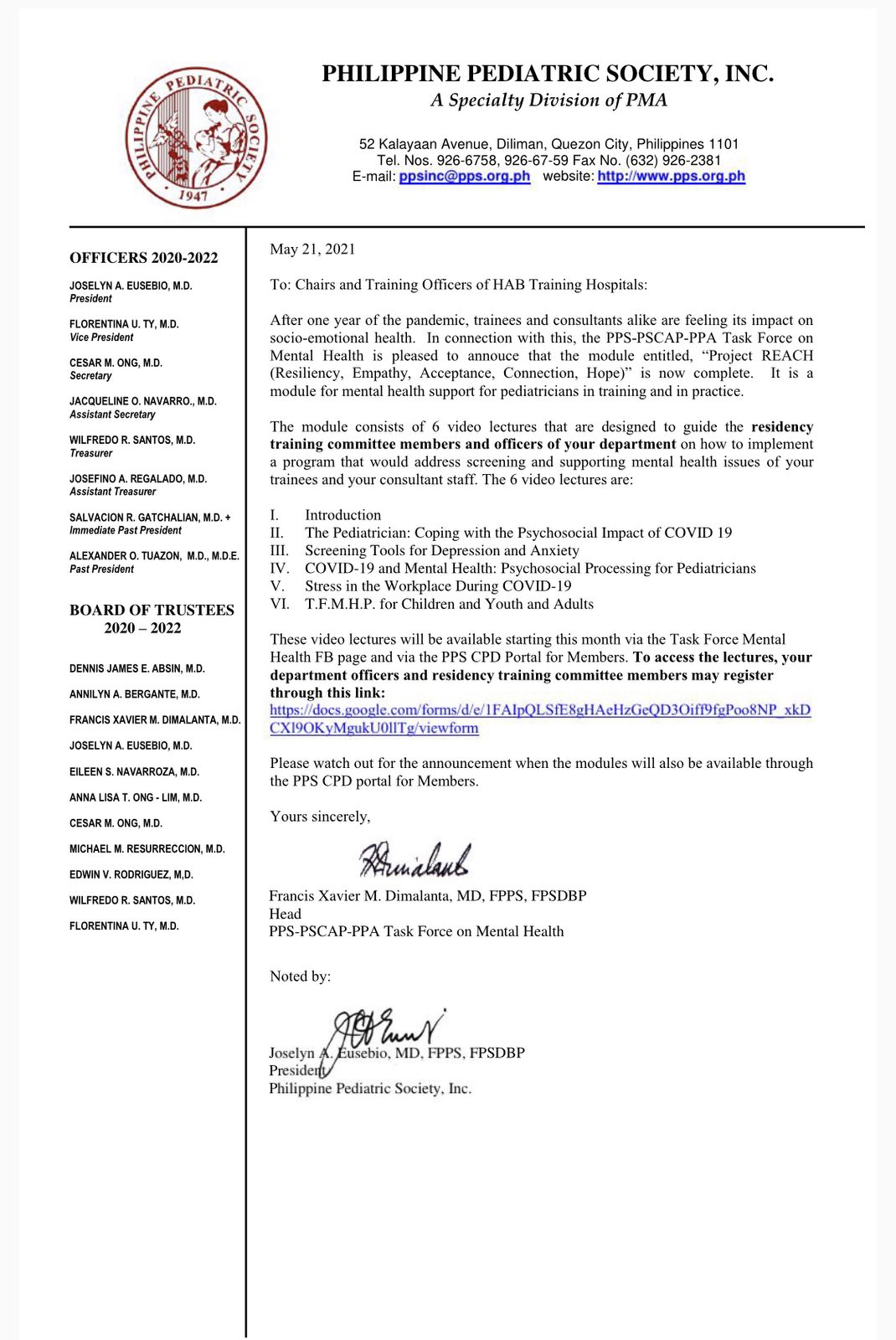
Task Force on Mental Health Modules
In celebration of Mental Health Awareness Month, the Philippine Pediatric Society (PPS) Task Force on Mental Health for Children and Youth in cooperation with the Philippine Society of Child and Adolescent Psychiatrists (PSCAP) and the Philippine Psychiatric Association (PPA) present a module for Pediatricians in Training and in Practice called Project REACH starting this May 2021 via PPS-PSCAP TASK FORCE ON MENTAL HEALTH Facebook Page.
To access the module, pls register through this link:
https://docs.google.com/forms/d/e/1FAIpQLSfE8gHAeHzGeQD3Oiff9fgPoo8NP_xkDCXl9OKyMgukU0llTg/viewform
I. Task Force on Mental Health Course Introduction
Francis Xavier Dimalanta, FPPS, FPSDBP
II. The Pediatrician Coping With the Psychosocial Impact of Covid 19
Robert Buenaventura, MD, FPPA
III. Screening Tools PHQ9 & GAD
Jacqueline O Navarro, MD, FPPS, FPSDBP
IV. COVID 19 and Mental Health Psychosocial Processing for Pediatricians
Rhodora Andrea M. Concepcion, MD, FPPA, FPSCAP
V. Stress in the Workplace During Covid 19
Vanessa Kathleen Cainghug, MD, FPPA, FPSCAP
VI. Action Plan TFMHP
Francis Xavier Dimalanta, FPPS, FPSDBP
Coming Soon
Infobox on Measles
INFOBOX ON MEASLES
Q and A about Measles and MMR vaccines
Measles is a highly contagious illness that begins with mild to moderate fever, cough, runny nose, red eyes and sore throat. Two or three days after symptoms begin, tiny white spots (Kopliks spots) may appear inside the mouth.
Three to five days after the start of symptoms, a red or reddish-brown rash appears.
The rash usually begins on a persons face at the hairline and spreads downward to the neck, trunk, arms, legs and feet.
1. My two-year-old son has been having fever, cough, colds and sore eyes for three days. Hes been exposed to a neighbor who had measles two weeks ago. Could this be measles? Can it develop even if he was given measles vaccine at 9 months? Do I have to isolate my son?
The average interval between onset of signs and symptoms and contact with a known measles case is 7-14 days, so your son may have measles because the vaccine given at 9 months may lead to decreased immunogenicity due to the presence of maternal antibodies.
Children who were given measles vaccine at 6-9 months should have received two more doses of measles/mumps/rubella (MMR) vaccine (at 12-15 months and 4-6 years of age or earlier) to achieve optimal protection.
Measles can be transmitted to others 4 days before, up to 6 days after the appearance of the rash thus, your son needs to be isolated.
2. What about my six-month old son, how can I protect him?
Your 6-month old son could have been protected if the measles vaccine had been given within 72 hours of exposure to his brother. If you were unable to have him vaccinated within this period, you will have to wait for 21 days to see if he will develop the disease. If he does not naturally develop measles infection, you can have your infant vaccinated then.
However, another option is for him to be given immunoglobulin within 3-6 days post- exposure. Ask your pediatrician for the best course of action.
Measles vaccine is recommended to be given at 9 months, however, during outbreaks it can be given as early as 6 months.
3. My five-year-old has already received two doses of MMR (mumps, measles and rubella) vaccine. Hes been exposed to his cousin who has measles, does he need an additional dose?
No further doses of measles-containing vaccine are recommended for those who have received two doses of MMR after the age of 12 months, given at least 28 days apart.
4. My son has been diagnosed to have measles. Is there anything that can be given to shorten the disease and prevent complications?
No specific anti-viral treatment is available for children with measles. However, it has been found that giving vitamin A once daily for two days can reduce the rate of complications. Your doctor can prescribe the dose appropriate for the age of your child.
When can he go back to school?
Children with measles should be isolated for at least 6 days after rash onset to prevent spread of the disease. He should also be fully recovered before sending him back to school.
5. My nine-month-old has been diagnosed with measles. He still has fever, but his rashes have darkened and started to peel off. Is it still part of the course? What are the complications of measles?
The fever of measles may become higher once the rash appears and should disappear within 48 hours once the rash reaches the feet.
Recurrence or persistence of fever may indicate the presence of complications, which occurs in about 30% of patients. These include pneumonia, ear infections and diarrhea. Encephalitis (brain inflammation) is a very rare complication. In a very young child who develops measles, a rare but fatal brain disease called SSPE (subacute sclerosing panencephalitis) may be seen 7-10 years after the measles infection.
6. My 1 y/o baby had measles when he was 8 months old. Can he develop measles again?
Patients who have had measles are immune to the disease throughout their lifetime, unless a severe problem with their immune system occurs.
Should he still receive an MMR vaccine?
Although he does not need the measles vaccine, and since separate mumps and rubella (German measles) are not available, he should still receive two doses of MMR (measles, mumps, rubella) vaccine to protect him against mumps and rubella. MMR in this child may be given as early as 1 year of age.
.
7. My 13 y/o son was exposed yesterday to a schoolmate who was diagnosed with measles. I am not sure if my son had one or two shots of MMR before. Is it safe to give another dose now?
In cases where vaccination status is unknown, two doses of MMR is still recommended, and it is safe. MMR vaccine can be given within 3 days from exposure to his schoolmate to possibly prevent or minimize the impact of the disease.
When is it safe to say that he did not get infected by his classmate?
If he does not develop measles infection within 21 days after last exposure to the patient who is contagious, then he did not get infected.
8. A neighbor is saying that its better to just let my baby naturally get the measles infection since it will give him life-long protection. Is this true? Will the measles/MMR vaccine protect my child from getting the infection throughout his lifetime?
Yes, he will have life-long protection after getting measles infection but, there is a high incidence of complications like pneumonia, ear infections, malnutrition, neurologic problems and even death. The protection from live vaccines such as measles is like having the natural infection in terms of inducing immune response but without these complications.
9. I am afraid my 3-month-old will develop measles after hearing about the outbreak. Can my baby receive measles vaccine?
Measles vaccine is only indicated for infants 6 months or older. Babies less than 6 months old are usually protected if their mothers had measles or were given MMR vaccine previously.
10. My 3 y/o child received two doses of MMR vaccine and later on, was diagnosed with autism. I read from social media that MMR vaccine is associated with autism. I dont want my second child to receive MMR since it might cause the same condition. Is this true?
This has been proven to be patently FALSE. Scientific evidence do not link MMR vaccine with autism. This is based on many studies, which included hundreds of thousands of children in different countries. The studies were well-controlled and done by multiple investigators. The doctor who authored the article linking MMR with autism used fake data. His license to practice medicine has been revoked, and the article has been withdrawn.
Infobox on Vaccines
INFOBOX ON VACCINES
Q and A on Vaccination
Parents are concerned about the health and safety of their children and administering vaccines is one of the best ways to protect them against infections. Although vaccines are manufactured using disease-causing organisms, these viruses and bacteria are destroyed or weakened, allowing the immune system to defend the body against the disease while preventing or minimizing its symptoms.
1. Why are vaccines important?
Vaccines are important because they prevent certain childhood diseases, which are highly communicable and may lead to serious consequences both in children and in adults. Vaccines also play a role in reducing the risk of infections that are not common but are associated with severe life-threatening conditions and/or disabilities. Before vaccines became widely available, many children died from diseases that vaccines now prevent.
2. Wont getting the disease provide better protection?
In most cases, being vaccinated provides the same quality of protection as getting the disease itself, with the advantage of avoiding the complications and risk of death.
There are some diseases like tetanus and diphtheria, which in spite of the child getting the infection, will not provide protection and thus, will still require vaccination.
Although vaccination will not guarantee 100% protection, vaccinated children, if they do develop the disease, are expected to have the milder form.
3. Who needs to be vaccinated?
Although most people consider vaccination as necessary in infants, it is equally important in children, adolescents, and adults. Other high-risk groups such as those who are immunocompromised or have chronic conditions like heart and lung diseases will also need to be given certain vaccines.
In certain situations, post-exposure vaccination is necessary. An example of this is rabies vaccine in a child bitten by a dog.
4. What happens if I cant remember the vaccines that were given to my child and Ive lost his baby book?
If your childs vaccination record cannot be obtained, he should be given the missed vaccines depending on his present age and medical history. If you are worried that your child might be given more vaccines than needed, extra doses will not lead to adverse reactions. In fact, missed vaccinations are more dangerous since these may lead to low protection or no protection at all.
5. What are the recommended vaccines?
The following table lists the vaccines that are recommended for children and adolescents by the Philippine Pediatric Society and the Pediatric Infectious Disease Society of the Philippines for the year 2020. Your doctor may also recommend other vaccines. Vaccines are given using different schedules, which you can discuss with your doctor.
| VACCINE | Number of Doses |
|---|---|
| BCG | 1 |
| Hepatitis B | 3 or 4, depending on the schedule used |
| Diphtheria-pertussis-tetanus (DPT) | 5 |
| Poliomyelitis | 5 |
| H. Influenzae Type B | 4 |
| Rotavirus | 2 or 3 |
| Pneumococcal | 4 |
| Influenza | 2 doses initially (until 8 years old), then yearly thereafter |
| Measles | 1 |
| Japanese B encephalitis | 2 |
| Varicella/ Chickenpox | 2 |
| Measles-mumps-rubella (MMR) | 2 |
| Hepatitis A | 2 |
| Human Papilloma Virus | 2 or 3 |
Other vaccines may be recommended in special situations. Ask your pediatrician about these.
6. Should I expect any side effects after vaccination?
Side effects can occur with any medicine, including vaccines. In most cases, vaccines cause only mild side effects, if any, such as fever, rash or soreness at the injection site. Slight discomfort is normal and should not be a cause for alarm. Paracetamol may be given if your child develops fever while cold compress may be applied for the pain and swelling at the injection site.
Rarely, people experience more serious side effects like high fever or incessant crying. Signs of a serious allergic reaction when present, will often be observed within 30 minutes of the vaccination. These will include difficulty of breathing, hoarseness, rashes, paleness, weakness or dizziness. Inform your doctor immediately if you notice any severe signs and symptoms.
7. What does catch up immunization mean?
Catch up immunization refers to the giving of vaccines that were not given on the recommended immunization schedule, for whatever reason. When the child or adolescent is brought to the clinic, the parents should be informed of the need for continuation of immunization as well as the new recommendations and new vaccines.
8. My son who is 6 years old had his vaccinations in the health center during his 1st year of life. From that time on, he has not received a single vaccine. Will he still need vaccination? What are these vaccines?
Local health centers provide the basic (National Immunization Program-NIP) vaccines using government funding, during the first year of life. These include BCG, 2 doses of rotavirus, 3 doses of DPT, polio, H. influenza b (Hib), hepatitis B, pneumococcal conjugate, measles and MMR.
If these vaccines were given, your son will still need boosters for DPT, polio, Hib, hepatitis B, pneumococcal conjugate and 2nd dose of MMR and other vaccines to improve levels of protection.
Since there are recommended vaccines that will prevent many other diseases (such as chickenpox, pneumococcal, hepatitis A, influenza, to name a few), children who received NIP vaccines should be given the opportunity for protection against these diseases.
Your pediatrician can provide a schedule that best meets your childs needs.
9. I have been told by our doctor that my teenage daughter still needs vaccination. What vaccines does she need?
Your daughter needs the following:
Childhood vaccines, which she may have missed during that period (catch-up vaccines)
Those whose protection will wane over time (such as diphtheria, pertussis and tetanus booster)
Vaccines given yearly (such as flu vaccine)
Vaccine against cervical cancer
10. Do all female children and adolescents need a vaccine against cervical cancer?
The anti-cervical cancer vaccine is intended to prevent infections with the types of human papilloma virus most commonly associated with genital warts and changes in the cervix which can lead to cervical cancer.
Even if there is no family history of this disease, these changes can develop once exposed to the virus.
Does my son need this as well?
Males can benefit from the vaccine in the prevention of genital warts.
11. My son is due for vaccination in a weeks time. However, my husband was symptomatic for COVID infection and tested positive last week. We are only 3 in our household. My son and I are asymptomatic and never had a swab test done. Can I continue my sons vaccination next week or should it be re-scheduled?
If you and your child remain asymptomatic, vaccination of your baby may be re-scheduled after 2 weeks (quarantine period) from the last time you and your baby were exposed to your husband.
Vaccination visits should be postponed to avoid exposing healthcare personnel and other patients in the vaccination setting to SARS-CoV-2. When scheduling or confirming appointments for vaccination, notify your Pediatricians office in advance.
Immunization During the Pandemic:
Heres why vaccination is important in the first 1,000 days of life
By: Dr. Joselyn A. Eusebio
President, Philippine Pediatric Society
Fear of COVID-19 has caused many children to miss scheduled vaccinations. This poses a high risk of an impending outbreak of vaccine preventable diseases like measles, on top of an ongoing pandemic. To help address this, innovative solutions such as drive-through vaccinations and home visits were made in place of clinic consultations during the lockdown. But a great majority of parents have opted to wait for the return to normal.
This is just a reminder of the importance of vaccination. Through immunization, vaccines help develop a childs natural defenses to fight vaccine-preventable diseases (VPDs). Immunization is best done prior to the exposure of a child to viruses and bacteria for which vaccines are available. Most of these vaccines are given during your child’s first 1000 days of life.
This healthy start paves the way for lower risks of both acquiring and spreading the infection to the immediate family as well as to the community, thus preventing outbreaks of these diseases.
According to UNICEF, there was a decline in child immunization coverage last year, and this coverage is projected to decline further due to the disruption of routine immunization activities caused by COVID-19. It is estimated that this will affect at least 2 million children under two years of age.
There is hope that we can go back to pre-pandemic vaccination coverage and even surpass this, thus avoiding outbreaks similar to what we have seen with measles in 2017- 2019 and polio in 2019 up to the present time.
Here are essential truths about having babies vaccinated yes, even while the pandemic is at large:
1. Hospitals and doctors’ clinics have made sure safety protocols are in place for well-baby check-ups. Visits to the pediatrician for immunization shots are safe, thanks to guidelines formulated by local experts. These guidelines describe how to safely and efficiently conduct vaccinations and out-patient visits to protect children, parents and physicians. It is best to set an appointment with your physician prior to the visit.
2. Vaccines have passed extensive safety and efficacy studies prior to licensure.
3. The first 1,000 days in an infants life are critical for receiving immunization on schedule. Recommended vaccinations that should not be missed during this period are: Bacilli Calmette-Guerin (BCG), Hepatitis B, Diphtheria, Tetanus, Pertussis, Polio, Haemophilus influenzae type B (DTaP-IPV-Hib), Rotavirus, Pneumococcal, Mumps, Measles, and Rubella (MMR), Influenza, Japanese Encephalitis, Hepatitis A, and Varicella.
4. In the event that a child missed a vaccination, he or she is left vulnerable to a disease that could be fatal. For example, a baby that missed an MMR shot, could acquire measles and suffer from complications such as pneumonia, ear infections, neurologic disorders, and even death. It is never too late to catch up on immunizations.
As a parent, you can do your part in protecting your baby during this pandemic and have a hand in ensuring your babys health. Have regular consults with your healthcare provider regarding immunization schedules. Follow health and safety protocols when setting appointments and during visits to health facilities. While the world is waiting for a vaccine against COVID-19, you can call the shots for your babys protection and have your childs immunity strengthened today.
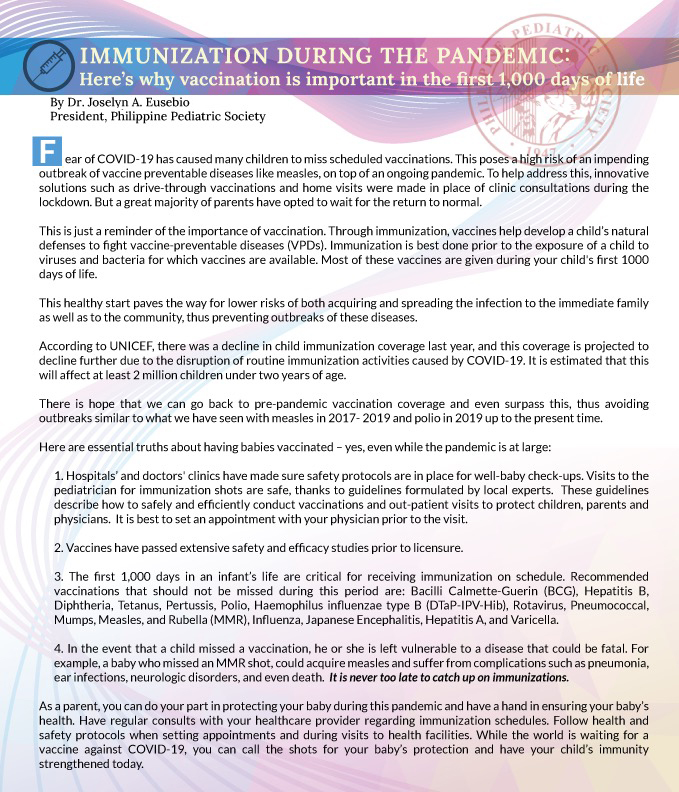
Western Visayas Chapter

PPS Western Visayas Chapter became a new chapter in 2016. However its history dated back to 1971 when a chapter in Western Visayas region was organized by twelve paediatricians in Bacolod City as the pioneer members. It was then called as Negros Occidental Chapter.
Dr. Salud Javelosa was the founding president. The highlight of her tenure was community involvement and service. The first major participation of the chapter was during the 8th PPS annual convention when Dr. Javelosa was a plenary speaker on the topic Community Pediatrics
Five years later, Dr. Natividad Aromin took over the presidency in 1976. New members from Iloilo and other parts of Panay joined, thus the name was changed to Negros Occidental – Western Visayas Chapter. The chapter won for the first time the most outstanding small chapter award due to projects undertaken in child advocacy.
The first seminar on primary health care was held during the term of Dr. Hester Villanueva. in 1979. Dr. Villanueva and Dr. Aromin represented the chapter in the International Pediatric Congress in Barcelona, Spain. The chapter was awarded the most active affiliate society of The Negros occidental Medical Society in 1980.
In 1981, Dr. Marie Casenas became the first president from Iloilo City. Information dissemination on preventive pediatrics and nutrition through radio programs and lectures were emphasized during her term. That year, the chapter won the most outstanding small chapter award for community service.
Dr. Suzette Elegado was elected president in 1983. She initiated the Regional Systems Network (RESYNET) program of the mother society. During her tenure, seminars on school health among public school teachers and various lectures on oral rehydration, breastfeeding and immunization were conducted. The chapter won the outstanding chapter award for two consecutive years.
In 1985. the first male president of the chapter was elected in the person of Dr. Manuel Posecion. One of the chapters outstanding accomplishments during his term was setting up the poison control center at the Iloilo Doctors Hospital emergency room complex to service the whole of Western Visayas. The chapter for the 4th time was awarded the most outstanding chapter award in community service.
Dr. Lourdes Espina took over the helm in 1986. Under her leadership, the chapter launched its first scholarship program for high school students. The chapter also participated in a collaborative study on national anthropometric measurement for Filipino children. Outreach programs to different barangays were also intensified.
The term of Dr. Ma. Victoria Villareal from 1987 1988 started with Adopt a school Project in Barrio Obrero offering free elementary education to low income families. There were regular appearances in the local TV programIkaw Kabuhi Ko with lectures on child health. Medical services were also extended to various government and charitable institutions like immunization and deworming.
In 1988, Dr. Lucia Iledan was the chapter president. Under her stewardship, the chapter embarked on an intensive community development program. It adopted one barangay as recipient of its various projects bio-intensive gardening, chlorination of water wells, mothers class and deworming. For its efforts, the chapter won the Child Advocacy award in 1989 and the Community Service Award in 1990.
Dr. Doris Mendoza was installed as the 10th president in 1990. During her term, the chapter won the most outstanding chapter in child advocacy award for its child survival activities, promotion of pro-child environment in the community, program for health care of street children and provision of their education and recreation and measures against child abuse as well as speech and hearing impairment.
In 1992, Dr. Imelda Nepomuceno continued the activities on child advocacy. Information dissemination on nutrition and breastfeeding through radio talks and lectures were intensified. The chapter received citations from the Negros Occidental Medical Society and Rotary Club of Bacolod West for the solid support the local PPS chapter extended to them in all their civic action programs.
Intervention programs for street children were advocated during the term of Dr. Emiliana Carmona in 1993 to 1995. Street children from 13 barangays in Iloilo City were targeted with value formation programs, medical missions and encouragement for empowerment through parental value formation activities and networking with local NGOs in the city. The chapter helped to establish the Iloilo Friends of the Handicap Foundation initiated by Dr. Linda Que whose activities were directed towards information dissemination, facilitation of diagnostic and therapeutic intervention and special education programs..
Child advocacy remained the top priority during the term of Dr. Peter Sogono from 1995 1997. Activities undertaken were programs for the protection of children under difficult circumstances and projects for the handicapped and abused child. The chapter also embarked on activities geared towards improving the medical education of PPS members, government physicians and private practitioners.
Dr. James Woo assumed the presidency in 1997 – 1999. The highlights of his term were: strengthening of the integrated residency training program of the different participating hospitals through grand rounds, clinico-pathologic conferences and integrated lecture series, holding of mini post graduate courses sponsored by each participating hospital which also served as a fund raising activity of the said hospital; community involvement through the Dulot ni Nanay lecture series conducting lecture workshops on child health care community initiative which aimed to promote mother baby friendly initiatives and to educate community based health workers on mother empowering programs, social involvement through the PPS Chorale which won the grand prize during the PPS Golden Anniversary Celebration choral competition.
During the term of Dr. Antonia Gensoli in 1999 2001, the chapter helped strengthen DOH activities disseminating information on the principles of Integrated Management of Childhood Illness (IMCI). It embarked on Baga Project wherein free antiTB drugs were supplied to PPD positive children. A directory of local PPS members was also initiated during Dr. Gensolis term.
Advocacy projects for the community were continued during the term of Dr. Stella Paspe from 2001 2003. The integrated residency training program was further strengthened with the creation of uniform guidelines for the promotion of pediatric residents. Another accomplishment was the approval of the criteria for good standing among local chapter members. Continuing medical education was also a top priority. The first postgraduate course and parallel lay symposium was held last July 2002 with a big success. With the scientific lectures and symposia it sponsored, the chapter won the most outstanding chapter in continuing medical education award in 2003.
Dr. Diana Nandwani succeeded the position in 2003. During her one year term, she was able to accomplish so much that the chapter was again voted as the most outstanding chapter in community service for the year 2004 for its series of immunization activities to orphanages and other institutions and its active participation in the campaign for a clean and green environment.
Community involvement was the thrust during the term of Dr. Joseph Aldric Gaspar in 2004 2006. Integrated Community Pediatric Residents Training Rotation Program was established in Igbaras, Iloilo.. Along with it, the Total Newborn Package Program was initiated and lectures on primary health care for Barangay Health Workers were conducted. To preserve and maintain the Maasin Watershed, the Adopt a Mountain Project was put in place. Due to these activities, the chapter was awarded the most outstanding chapter award for community service.
The primary focus of the term of Dr. Ma Eugene Amante in 2006 2008 were the effects of the environment, media, and family to the child. Thus, lectures and TV appearances on the effects of media to children were made. Flagship projects were Aton Kabataan Aton Amligan lectures on child abuse and substance abuse in schools, Balik Eskwela Program to keep the children away from the streets by awarding and recognizing children with complete attendance and good scholastic records. Detection of iron deficiency anemia among Grade I pupils and subsequent iron supplementation to affected pupils were also done. The chapter joined with the private sector mobilization for family health projects. The chapter was awarded the most outstanding chapter in research for 2007.
Dr. Teresita Geroche became president in 2008 to 2010. The chapter members were active in the care of the environment by planting mangrove trees and maintenance of trees in Barangay Bagsakan in Alimodian, Iloilo for the Maasin Watershed were continued. Likewise, there was also active participation of the local members in medical missions for hardly hit flood victims brought by the wrath of typhoon Frank particularly in the town of Pavia and the district of Jaro. Dengue awareness program was given emphasis with the Ilonggo Pediatricians Knock Out Dengue Project in the town of Oton, Iloilo which significantly reduced the incidence of dengue in the locality. The chapter was awarded the most outstanding chapter in continuing medical education in 2009 and the most outstanding chapter in research in 2010.
Programs in continuing medical education, research, community service and child advocacy were continued during the term of Dr. Ma. Victoria Ravina in 2010 to 2012. The chapter was the first chapter to have a program for disaster preparedness. The Perla Santos Ocampo award for the most outstanding chapter for community service and child advocacy was given to the chapter.
Dr. John Colacion was the chapter president in 2012-2014. It was during his term that Objective Structure Clinical Exam (OSCE) was held for graduating Pediatric residents in training. Prior to that, a workshop for consultants was conducted about OSCE, A three month review for PPS Specialty Board special exam was organized by subspecialist members of the chapter. The close to 50 passers were welcomed by the chapter. The chapter joined in the Project Rebuild as a partner in the rehabilitation of areas hardly hit by typhoon Yolanda. Rehabilitation of the damaged water system in the island of Naborot in the town of San Dionisio was financed by the chapter. Medical missions in the northern towns of Iloilo and Antique which were greatly affected by Typhoon Yolanda in November 2013 were also done
In 2014-2016 Dr. Jose Pandan was the chapter president. Programs in continuing medical education, research and community service and child advocacy were continued. The chapter has a growing number of members and there was a plan to have a separate chapter for the Negros Occidental group and the Panay group. However, there was a ruling that there could only be one chapter per region and that hindered the separation. In May 29, 2015 Negros Island Region was created through Executive order 183 signed by President Benigno Aquino III. Thus there was now a reason to separate. A process was followed for the separation, new set of officers and board members were elected in February 2016. Finally, during PPS national board meeting with the chapter presidents in April 2016 it was decided to grant separation of the chapter into Negros Island Chapter (Negros Occidental and Negros Oriental) and Western Visayas Chapter (Aklan, Antique, Capiz, Guimaras and Iloilo).
Dr. Cristina VC. Woo was the first chapter president for the newly created Western Visayas Chapter in 2016-2018 The chapter was involved in many activities of the society. Certain advocacies like Campaign Against Tobacco Smoking was conducted for high school students in Iloilo City. Our entry for the poster making contest won first place in the national level. Integrated Management of Childhood Illnesses Workshop was held at the College of Medicine of West Viasyas State University. The chapter partnered with Team bakunanays Public Health students of UP Visayas. UNILAB foundation, DOH, Municipality of Pavia, Ungka II Elementary School to help increase immunization coverage among grade school students.
Dr, Joselito E. Caso served in 2018-2020. The members were encouraged to be PPS (punctual, participative, simple). The first Philippine version of Neonatal Resuscitation Program was conducted for pediatric residents in training and pediatric consultants. Advocacies in line with the mother society were conducted like Campaign Against Teen-age Pregnancy, Disaster Preparedness,, Breastfeeding, Immunization among others. Partnership with Iloilo Provincial government was made during the dengue outbreak in 2019. Volunteer members went to four district hospitals (Cabatuan, Janiuay, Guimbal and Aleosan) and help in out patient consultations and management of admitted patients. The chapter was given a certificate of appreciation from the Department of Health Western Visayas for their support in the implementation Child Health Care Services. The first PPS WV Pediatric Forum was conducted last February 27-28, 2020.
This year, the year that COVID-19 disturbed the whole world is the year that the key of responsibility was transferred to Dr. Teresa Martirez-Hallegado. This is the year that restrictions, quarantines and strict health protocols are being implemented. Teaching and learning activities are mostly, if not all, virtual. Programs and advocacies are being carried out through social media. Empowerment of the members in the use of the different social media platforms is the initial project of the chapter. Encouraging the residents to create different video infomercials on the different advocacies of the society to continue reaching out to the community through social media. More video informercials and posters will be produced in the next months to increase awareness on COVID-19 and the ways to control and prevent its spread.
What is in store for the chapter in the next 2 years and the years to come? There would be more challenges along the way, but with the wisdom and experience the members had shared with mentors and senior consultants, they will come out victorious. This can be achieved with the cooperation of every member, properly equipped with the latest trends in patient care, updates in continuing pediatric education, commitment to be involved in community service and research, and participation in socio-cultural activities. Members would be ready to adjust to the changing times and face the challenges of life.
The legacy and tradition of excellence passed on by our predecessors will serve as inspiration to the present and future members of the society. The will and the passion to continue to strive for excellence in providing the best possible care for the Filipino child, the Ilonggos in particular live on.

